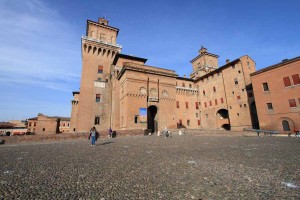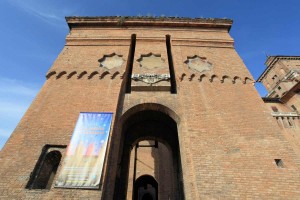
©Bigstock.com/mary416
What is the “ideal city”? And what does it look like? The concept of the perfect cityscape has been changing several times over the course of the centuries – what was right 300 years ago isn’t compatible with contemporary mobility concepts and urban development any more. Toward the end of the 15th century the reigning Este family decided to give Ferrara the first modern planned city centre in the world. The historic Renaissance centre is still regarded as the epitome of humanistic times and, together with the cultivated landscape of the Po Delta, was added to the illustrious UNESCO World Heritage list in 1995.
A taste of Ferrara’s history
In order to fully understand both the unique composition of this World Heritage Site and the reason for building such a city centre, let us first take you on a brief trip into Ferrara’s illustrious history. In contrast to many other places, the city in Emilia Romagna doesn’t have any Roman roots whatsoever. Instead it was likely first populated by lagoon dwellers at a river branch in the Po Delta in the 7th century. The region was only silted in the 12th century after a dam failure.
After Ferrara fell to the noble Este family in 1264, the city blossomed. The establishment of a university and the promotion of fine arts attracted scholars, painters and sculptors to the Po Delta. The number of inhabitants exploded to over 130,000 during Ercole I. d’Este’s reign, the city needed to grow rather urgently. Court architect Biagio Rossetti was instructed to expand and fortify Ferrara like a chessboard from 1490 onward. Building wide and straight roads – as opposed to the then standard of expanding outward from a city centre – was a first for Europe back in the day. Incorporating humanistic principles, city-specific requirements and local traditions created the ideal Renaissance city.
Walk through Ferrara’s historic city centre
Many glorious monuments of architectural grandeur, perfectly connected through the road development projected mentioned above, also known as Addizione Erculea, await you on and around Piazza della Repubblica. You might already be familiar with our extended walk through Ferrara’s Renaissance city centre – a wonderful tour with the most important highlights and sights of the city as well as some attractive insider’s tips. Let us introduce you to some of the most beautiful buildings, churches and palaces.
San Giorgio
Things don’t always turn out quite the way you expect them to. When constructions of Cattedrale San Giorgio, dedicated to the city’s patron saint, began in 1135, the initial plan was to create a Romanesque sacral building. Ultimately, completion of the ambitious project would be delayed by over 200 years bringing you today’s truly fascinating mix and clash of styles with Gothic charm. You’ll discover arcades, rosettes and pinnacles as well as biblical depictions and Este images on the marble façade. The inside, lined with works by artists from the school of Ferrara, surprises with elements of 17th and 18th century architecture.
By the way, we cannot recommend a walk around the cathedral highly enough. Among the things you’ll discover is an amazing Campanile and the canopied Loggia dei Merciai, a 15th century line of shops that still houses a few stores. The cathedral museum, however, can be found a few roads down in Via San Romano.
Castello Estense

©Bigstock.com/mary416
Why is there a moat in the heart of Ferrara? You’re not the only one asking yourself that. It surrounds Castello Estense, the former rulers’ house of the Este. A drawbridge leads you from Piazza Repubblica to the fort, originally intended as a stronghold to protect against potential national uprisings. It was only converted into the ducal residence in the mid-16th century. The ostentatious Este lifestyle feels close enough to touch in the splendid Sale Estensi. A fascinating journey through time ranging from Mannerism frescoes to grim dungeons in the basement awaits you.
City palaces
Fort and cathedral aside, a number of palaces are virtually beckoning you to sneak a peek inside. Here are some recommendations for your historic city centre tour:
- Palazzo Municipale: The former ducal Este palace used to be directly connected to Castello Estense. The stairway of honour, a roofed, cupola-capped 15th century masterpiece, is a particular eyecatcher. The palace now houses the city hall.
- Palazzo Schifanoia: Why so serious? Schifanoia loosely translates to “escape from boredom” and was fully dedicated to entertainment purposes. The Este rulers used to palace to get away from court monotony. A prime example of the Schifanoia concept is Sala dei Mesi with its, sadly poorly preserved, early Renaissance month frescoes.
- Palazzo Costabili: When the Sforza were banished from Milan in 1503, construction of the palace for court ambassador Antonio Costabili ceased as well. The magnificent building remained unfinished, but the halls painted by Garofalo are certainly worth seeing. Don’t forget to stop by the great archaeological museum!
- Palazzo dei Diamanti: Over 12,000 marble blocks with varyingly aligned, diamond-pointed rock tips turned Biagio Rossetti’s architectural masterpiece into a sight to behold. What used to be a living space and residence has since become Pinacoteca Nazionale with paintings from the 14th to 17th
Trip to the Po Delta
A genuinely unique cultivated landscape, planned meticulously over the course of decades and centuries and completed with both technical prowess and a keen eye for nature, awaits you around Ferrara. The gradual drainage of the Po Delta, now home to a gigantic natural park among other things, laid the foundation for one of country’s most amazing habitats. Wetlands, forests, pine groves and biotopes, but also agriculture and residential houses await you between the provinces Ferrara and Ravenna. Delizie Estensi, a collection of approx. 30 villas throughout the city and its surroundings, where the rulers and their families used to live and rule from, assume a special role. You cannot rate their strategic importance for the development, administration and defence of the region highly enough.
Whether you want to experience architectural masterpieces, innovative city planning or the fascinating coexistence of man and nature– Ferrara and the surrounding Po Delta are always worth a visit. ZAINOO wishes you tons of fun with what will certainly be an unforgettable trip to the ideal of Renaissance!